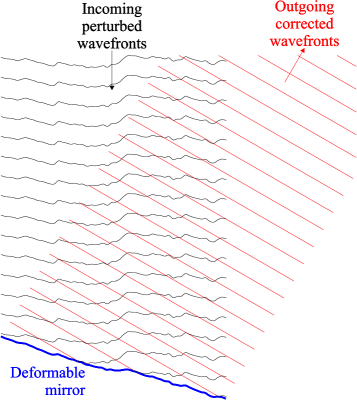How to Build a Laser Death RayAdaptive Optics |
 As described in the section on twinkle, light passing through the air gets distorted by turbulence in the air. Light is a wave, and propagates as a series of ripples in the electromagnetic field. Light from a point source would give ripples that were perfectly spherical, centered on the source. Far away, these ripples would appear as nearly flat wave-fronts passing by. The distortion due to the air adds jitter to these wave fronts, making them uneven. By bouncing these uneven wave fronts off a mirror that is dynamically shaped to exactly cancel the unevenness, the wave fronts can be made smoot again and the effect of the air canceled out.
As described in the section on twinkle, light passing through the air gets distorted by turbulence in the air. Light is a wave, and propagates as a series of ripples in the electromagnetic field. Light from a point source would give ripples that were perfectly spherical, centered on the source. Far away, these ripples would appear as nearly flat wave-fronts passing by. The distortion due to the air adds jitter to these wave fronts, making them uneven. By bouncing these uneven wave fronts off a mirror that is dynamically shaped to exactly cancel the unevenness, the wave fronts can be made smoot again and the effect of the air canceled out.
This is great for astronomy, where we want to measure light from point sources that has passed through the air. But for a death ray we want to do the reverse. We take the initially smooth waves coming out of the laser and bounce them off a deformable mirror to defocus the waves so that the turbulence in the air re-focuses them to a tight spot on the target.
Adaptive optics requires three components. First, a wave-front sensor that detects the distortion in the incoming light. Second, a deformable mirror whose surface can be altered in shape on a timescale less than that characteristic of atmospheric fluctuations. The dynamically shaped mirror is made by making the mirror surface out of a flexible sheet and placing a grid of electro-mechanical actuators behind it to push or pull as needed to get the right shape. Third, a computer is needed to interpret the readings of the wave-front sensor and determine how the mirror should be deformed.
|